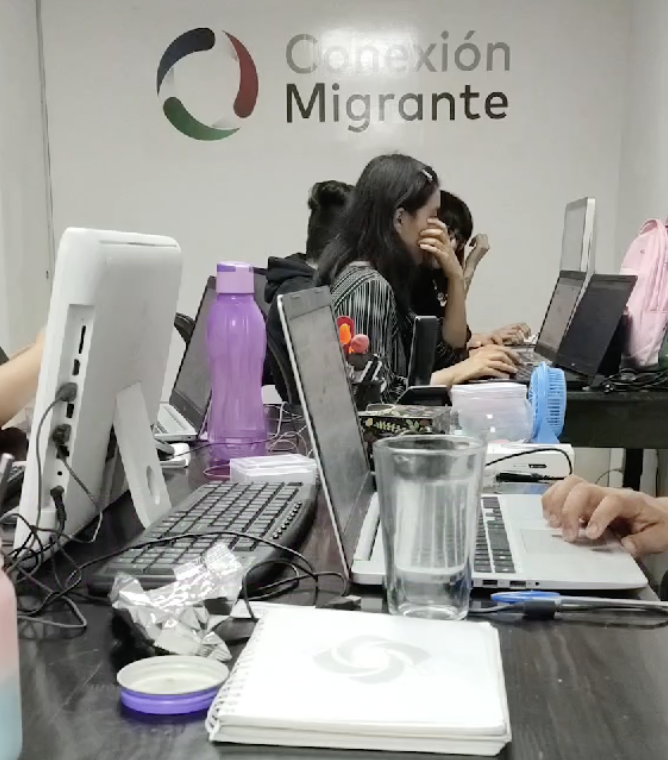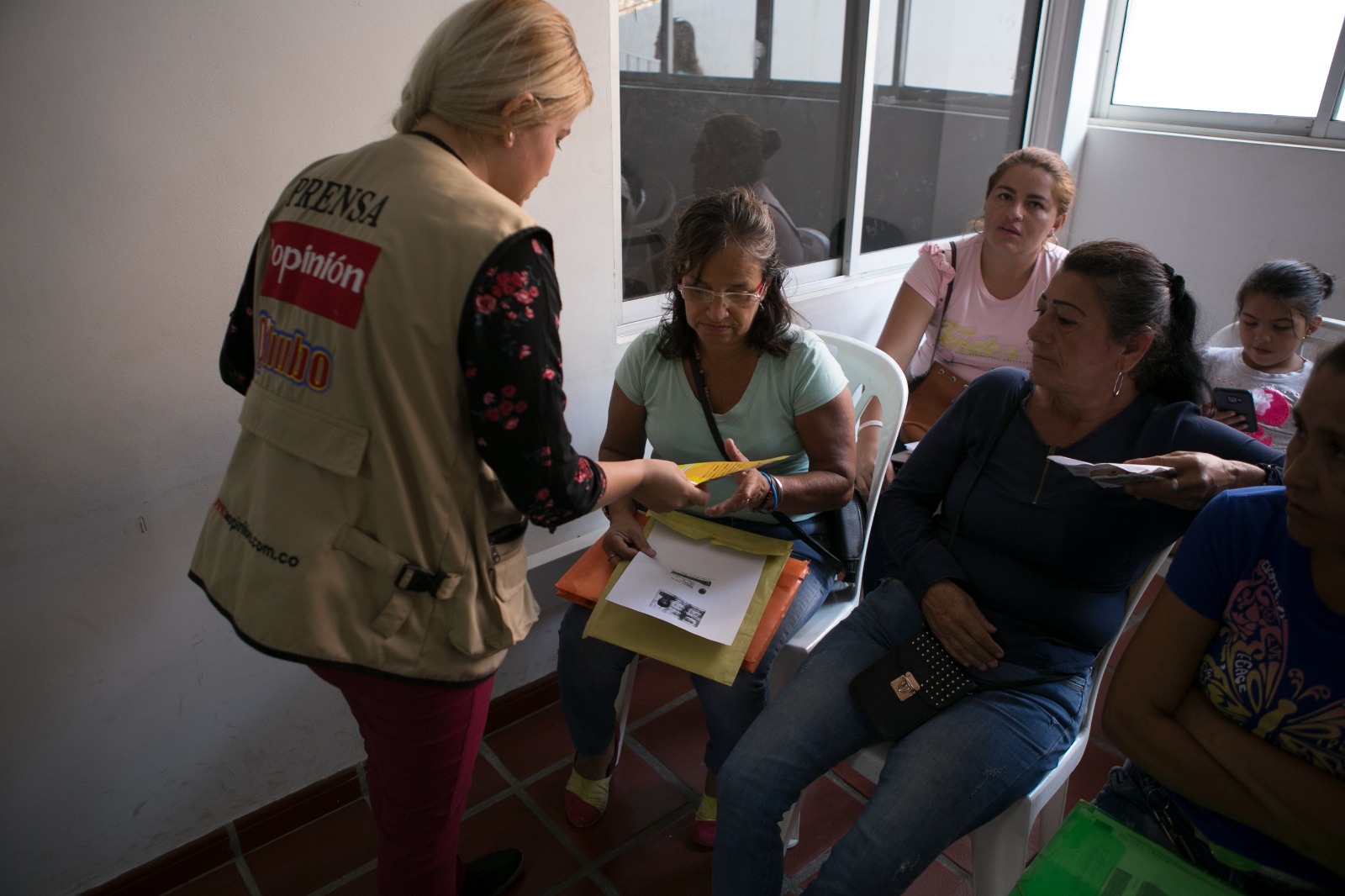Countering narratives of hate, listening to the migrant community, providing useful information and monitoring migration policies are some of the practices that journalists who report on and for migrant communities in Latin America recommend implementing to offer better immigration coverage in the face of Donald Trump's second term as president of the United States.
The new administration in the White House will present multiple communication challenges, due to a climate of fear, confusion and disinformation that was created after the next president announced his immigration enforcement plans.
The press must be alert and prepared to avoid contributing to this climate, migration journalists consulted by LatAm Journalism Review (LJR) said.
In terms of migration coverage, during Trump’s first term many news outlets erred by choosing to tell the narratives of politicians rather than those of the migrants themselves, said Patricia Mercado, founder and director of Conexión Migrante, a media outlet dedicated to reporting for Latin American migrants in or going to the U.S. And it did a lot of harm, she added.

Conexión Migrante started 2025 with a project to bring to video content to educate readers about processes and procedures. (Photo: Courtesy of Conexión Migrante)
For this second Trump administration, journalists must work together to transform the narratives imposed by politicians, which often generate hatred, fear and division, into more complete narratives, Mercado said.
“It’s true, Donald Trump gives us some beautiful headlines. Every statement of his is brutal and draws attention, and people consume it. It’s a very big temptation,” Mercado told LJR. “But there must always be a reflection on what else I can do. I mean, yes, I’m going to publish this, but how do I explain to people what what he said really means?”
Cindy Espina, an independent Guatemalan journalist specializing in migration and a member of the collective Narrativas de Fronteras desde los Feminismos, said that there is a consensus among journalists specializing in migration that it is necessary to counteract negative narratives about migration with narratives focused on human rights or with angles that highlight the positive aspects of migration.
These new narratives, she added, must try to avoid making migrants the “other” and demonstrate empathy towards migrants.
“Migrants are also creating and contributing to communities, and I think it is valuable to talk about that in the midst of the speeches that the president and officials are going to make daily against the migrant population,” Espina told LJR. “Filling our publications more with these stories, I think, is an underexplored avenue in which we can counteract these anti-migrant rights speeches.”
Mercado agrees that new narratives on migration must inspire reflection in society on how migrants can be integrated into destination countries and how to better assimilate their contributions.
“How do we explain to people that migration is not bad, that migration brings progress, brings development, brings diversity?” Mercado said. “We have not painted that story. We always paint a story of tragedy, of crisis. We are only telling half the story.”
“Narratives of hope” and a diversity of voices are the main strategy of Guatemalan media outlet Prensa Comunitaria to counteract the narratives of fear, disinformation and hatred that exist towards the migrant community. The outlet carries out extensive coverage of the migration of Indigenous communities in the Central American country.
“The greater the diversity of voices and perspectives to do this type of journalism, the more we can focus on historical truth and on what people are feeling, experiencing and discussing,” Quimy de León, founder and director of the media outlet, told LJR. “That is also one of the alternatives to disinformation and polarizing discourses that seek to create a single, dominant truth.”
As an example of these “narratives of hope,” De León mentioned reporting Prensa Comunitaria has done in recent weeks on how Guatemalan migrants in the U.S. are organizing themselves in the face of possible measures by the incoming government, or coverage by other media on the contribution of the migrant community to the fires in Los Angeles.
In these new narratives, the correct use of language plays a fundamental role, Espina said. This language must also be aligned with the human rights approach and must avoid the use of analogies, alarmist terms and re-victimizing phrases, she added.
“We are talking about people with rights, many of whom have been victims in their countries of origin, in transit and also in their destination country,” Espina said. “We must be careful that our words and the way we report do not re-victimize people.”
Journalists should also question their use of the term “immigration crisis,” as it has been seen to contribute to deepening anti-immigrant discourse from politicians, Espina said.
“Is this really a migratory crisis or is it a crisis created to result in a humanitarian crisis at the borders?” Espina asked. “We must ask ourselves every time we write that word. What is really happening? These are humanitarian crises at the borders due to political and administrative decisions by governments.”
Given the climate of fear and confusion that currently prevails among the migrant community, quality information must be the main tool, Mercado said. This will not only help counteract narratives of hate, but will also help migrants make better decisions.

Estoy en la Frontera will focus on providing deported Colombian and Venezuelan migrants with information in the form of service routes and channels to attend to their needs. (Photo: Courtesy of Diario La Opinión)
“We need to explain the phenomena. The xenophobia that exists in communities here in Mexico, in the United States, and everywhere is because people do not have the information. And it is not their fault,” Mercado said. “It is a moment of reflection and of saying ‘how am I going to tell the stories?’ because that clearly affects society.”
This month, Conexión Migrante began a project to turn some of its most sought-after content on the site into videos, Mercado said. The goal, she said, is to strengthen the media outlet’s YouTube channel from fear to training readers on processes and procedures.
Faced with Trump's threats of radical actions, such as mass deportations, the digital media outlet Estoy en la Frontera, belonging to the newspaper La Opinión, based on the border between Colombia and Venezuela, is preparing to offer useful information for migrants from these countries who could be affected.
Keila Vilchez, editor of the media outlet, said that while La Opinión would cover news topics of possible changes in immigration policies, Estoy en la Frontera would focus on providing migrants with information in the form of service routes and support channels to address their needs.
“It is preferable that people really know what they have to do,” Vilchez told LJR. “We have to see what exactly these policies are that are going to be implemented to see where we are going to direct our content. Estoy en la Frontera has always been in line with looking for content that helps people.”
For example, Vilchez said, if there were deportations of Venezuelans or Colombians, the priority would be to investigate where those flights would arrive, since that normally depends on the relationship of the U.S. with the countries of origin of the deportees, as well as to provide information on how Venezuelan migrants can regularize their status once in Colombia.
She added that they will also seek to provide information on the legal process behind a deportation and the mechanisms that a migrant in the process of deportation can use.
“The focus will be on giving them the tools for regulation, because any migration process in any country in the world begins with a successful process for migrants to obtain a legal status,” Vilchez said. “We have worked on our coverage in that sense, always trying to promote safe migration, where people do not run risks.”
Content on topics such as migrants' rights, the institutions they can turn to, the emergency lines available to them or what to do if an immigration officer knocks on their door will also be very useful in the current climate of fear, Espina added.
“Sometimes we underestimate giving this type of information because it is not about hard topics, like what a politician said, or an analysis,” Espina said. “People do face fear, and I think that by giving them these tools, these information resources, we can help a little to calm those emotions and the fear they feel.”
In light of the wave of possible migration policies and measures that could be introduced in the region, Espina recommended that media outlets conduct monitoring and create databases to have control over all the information and avoid confusing people.
“There are many things coming up right now, so monitoring them on an Excel document or any other tool is going to be very useful,” she said. “For example, about the countries that report deportations, to see how much they are increasing, what type of population they are deporting and all that, to report correctly or to detect some anomaly and start investigating and following up on it.”
One of the main lessons that the first Trump administration left the Conexión Migrante team was learning to listen to the migrant community, Mercado said. Since its founding in 2016, the media outlet has had the challenge of building a relationship of trust with a vulnerable migrant community that trusts no one and is afraid. And to do so, knowing how to listen has been fundamental.

Media outlets that cover migration note a climate of fear and confusion among the migrant community in light of President Donald Trump's statements. (Photo: Screenshot from El Universal)
“We must not forget that migrants are not just numbers or countries, but people and we must have the ability to listen to them. Not just interview them, but listen to them,” Mercado said. “Media and journalists should be more alert to the disinformation that exists around the community, because they are a community that, being in a vulnerable situation, very easily falls into disinformation.”
The main way in which Conexión Migrante listens to its audience is through the Migrant Assistance Center, a call center to provide information and support to the migrant community. Through this, the media outlet has served more than 100,000 people in eight years, Mercado said.
“It is essential for us to listen to the audiences to find out what they need, and that is where the perfect formula came from,” Mercado said. “We are studying, creating new information and talking a lot with people to find out what their needs are, because things are going to happen that we have to be able to explain to them.”
The Prensa Comunitaria team is also working to listen to its audience, which is made up primarily of members of the various Guatemalan diasporas in the U.S. So far, disinformation and broadcasting of fear are the problems they have expressed most, De León said.
“We have seen that there is a lot of fear in the diaspora and the migrant community, even among those who have papers, due to the discourse that has been spread on social media and other channels by President Trump. They feel that there is a risk of deportation, whether you are legal or not,” the journalist said.
In light of Trump's second term, immigration journalists should not only focus on the US-Mexico border. There are other regions and countries where changes could occur in the coming months, the journalists said.
One such country is Venezuela, where a recent survey revealed that nearly three million people intend to emigrate this year, following the start of Nicolás Maduro's third term.
“Venezuela worries me a lot because it could be a factor that transforms migration again,” Mercado said. “We have to watch what Colombia, Peru and Spain are going to do, as these are the countries that receive the most Venezuelans.”
The Estoy en la Frontera newsroom plans to implement surveillance of the first 90 days of both the second Trump administration and the third Maduro administration to follow up on the information needs of migrants.
“We will be watching what happens,” Vilchez said. “Because [La Opinión] is a border newspaper and is located in Cúcuta, where about 80 percent of the people who stay in Colombia or simply pass through on their way to other countries come through, these issues have always been a priority for the newspaper.”
Central America is another geographic region to watch. In Guatemala, there are fears that the “safe third country” category agreed upon by Trump and former President Jimmy Morales in 2019, and repealed by President Biden two years later, could be revived. This status allowed Honduran and Salvadoran migrants seeking asylum in the United States to be sent to Guatemala to submit their applications.
“There is speculation that there has been pressure from the United States government on the government of President [Bernardo] Arévalo to accept or resume the idea of the ‘third safe country,’ so that Guatemala can be like a migratory shield for the United States to deport migrants from Central America,” Francisco Simón, territories section editor of Prensa Comunitaria, told LJR.
There are similar concerns in Panama, after the government of President José Raúl Mulino signed a memorandum of understanding on cooperation on migration issues with the United States last year. Since taking office on July 1, 2024, Mulino has emphasized his intention to close the country's borders to migrants crossing the region known as the Darien Gap on their way to North America.
“The current president of Panama is very attached to Donald Trump’s anti-immigrant line. In that sense, Panama could apply policies for the extension of the United States border as happened in Mexico,” Espina said. “The greatest attention in terms of monitoring should be in Panama and Darien, because new dynamics could arise that could cause another type of violence against migrants.”
Monitoring the effects and collateral damage of possible new migration policies of countries should also be a priority for journalists, Espina said.
Journalists should also be aware of what will happen with existing immigration policies, such as CBP One, the application that the U.S. launched in January 2023 so that immigrants in Mexico can schedule an appointment at a border crossing and request humanitarian parole. This tool is among the programs that Trump has promised to eliminate once he reaches the White House.
“One of the most important issues is what is going to happen with the CPB One application and all the appointments that are already authorized, and what is going to happen with the people who are already in the United States waiting for their appointments,” Mercado said. “There are a lot of people waiting for their appointments and a lot of people in Mexico still trying to make appointments.”